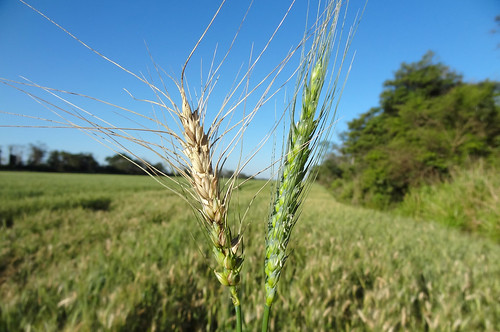
Wheat blast is a fungal pathogen that can devastate a crop and ruin entire harvests. Photo courtesy of Guillermo Isidoro Barea Vargas
This post is part of the Science Tuesday feature series on the USDA blog. Check back each week as we showcase stories and news from USDA’s rich science and research portfolio.
An epidemic of wheat blast is underway in Bangladesh, published reports say, and losses may be substantial in the six southeastern districts where it has been reported. Wheat blast is a crop disease caused by the Triticum pathotype of the fungus Magnaporthe oryzae (MoT). In nations where broad wheat blast epidemics have occurred, 30 percent losses have been noted, but localized areas have experienced 50-100 percent losses, according to Dr. Barbara Valent, fungal molecular geneticist at Kansas State University (KSU).
The U.S. Department of Agriculture’s (USDA) National Institute of Food and Agriculture (NIFA), through its Agriculture and Food Research Initiative (AFRI), has provided nearly $5.4 million since 2009 to support research on wheat and rice blast. KSU leads a multi-institutional research projectthat brings together expertise from University of Arkansas, University of Kentucky, the Ohio State University, Purdue University, and USDA’s Agricultural Research Service.
The team used genotyping – determining genetic variances of different strains of the pathogen – to discover basic, foundational information about resistance genes and the biology of the disease. Team members then created a blueprint of the origins of strains and how various isolates were related. The team has also developed a wheat blast diagnostic protocol that will soon be deployed through theNational Plant Diagnostic Network.
This knowledge will be crucial to understanding how virulent strains of the fungus move around the world. Wheat blast has been a major concern since its discovery in Brazil during a 1985 epidemic that spread to Bolivia and Paraguay.
“The pathogen’s genotype is greatly like the strains from Latin America, so the knowledge gained from managing blast in South America will be directly applicable to Bangladesh,” Valent said. Relationships are in place between the U.S. team and Bangladeshi scientists to facilitate the transfer on the technology.
How wheat blast got to Bangladesh is under investigation. The KSU-led wheat blast team is comparing the genetic fingerprint of known isolates with the isolates of the pathogen from Bangladesh. But, now that wheat blast is in the country, the ultimate concern is how farmers will manage the disease. The environment in Bangladesh is very favorable to MoT, so deploying wheat varieties that are less susceptible will be a key strategy, along with other integrated approaches to disease management.
Food security, having a reliable source of safe and nutritious food, is a real concern when a staple food crop suffers from a disease epidemic such as this. Wheat is the most widely produced food crop in the world, and second only to rice in value as a source of protein in the human diet. Previous disease outbreaks in the United States, such as wheat stem rust in the 1920s and ‘30s and southern corn leaf blight in the 1970s, were significant, but probably did not have the impact on the local population that this outbreak of blast will have in Bangladesh.
NIFA invests in and advances agricultural research, education and extension and seeks to make transformative discoveries that solve societal challenges.
No comments:
Post a Comment
Note: Only a member of this blog may post a comment.